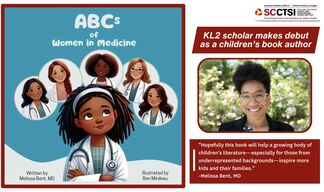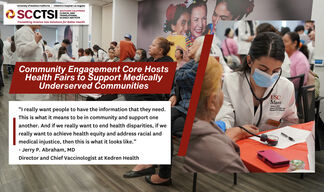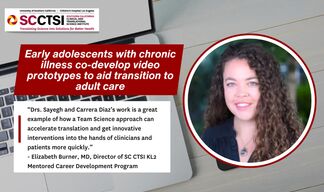SC CTSI Helps Demystify Federal Grants With Online Videos
TL1 scholar Jamaica Rettberg produced a video series to help fellow graduate students complete NIH applications.
When Jamaica Rettberg, a PhD candidate in the Department of Neuroscience at USC, decided to apply for a research fellowship from the National Institutes of Health (NIH), she knew it wouldn't be easy. The applications are famously complicated and take most people months to complete.
Rettberg was applying for what is known as an NIH National Research Service Award (NRSA, F31), intended to help doctoral students get additional training in fields related to their core focus. For Rettberg, who studies risk factors and therapies for Alzheimer's disease, the F31 would not only support her doctoral research, but would also enable her to get a Masters in Regulatory Sciences from the USC School of Pharmacy. She felt that a deeper understanding of the regulatory aspects of drug development would enhance the quality and efficiency of her research.

Jamaica Rettberg, a PhD candidate
When she started working on the NRSA grant, Rettberg made it a point to find out everything she could about the application process. "The NIH provides some guidance and explanations, but there was nothing really from the point of view of an applicant,” she said.
She took a seminar in the neuroscience department about NRSA grants and applications, sought advice from mentors and colleagues who had been through the process, and of course spent many days on her own parsing dozens of questions, running down required documents and information, drafting statements about research goals, and more.
Rettberg finally submitted her application, and in 2012 the NIH granted her the prestigious Ruth L. Kirschstein National Research Service Award.
Peer-to-peer: harnessing one student's knowledge to benefit others
That might have been the end of Rettberg's application saga, had not Cecilia Patino-Sutton, MD, MEd, PhD, and Director of Education for the SC CTSI Education, Career Development, and Ethics program, asked her to give a presentation about the application process for other pre-doctoral students in the TL1 program. The SC CTSI's TL1 program provides unique professional training for graduate students aspiring to careers as clinical and translational researchers.
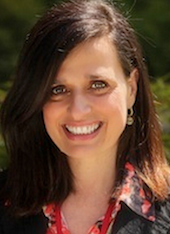
Cecilia Patino-Sutton, MD, MEd, PhD
Rettberg was happy to help. Using her own application forms as examples, she took fellow students step-by-step through the application process, from minute but important matters of font size and type to pointers on writing effectively about research goals. "It's much more helpful when you're hearing from a peer who has gone through the process recently and understands the sticking points," she said.
So well received was Rettberg's presentation that Patino-Sutton suggested she make it available beyond the USC community - by turning it into a video that could be posted online. It filled a much-needed gap: in an era when it is common to find answers or how-to guides on the Internet for even the most mundane matters, no such tutorial for the NRSA grants existed.
Of course, that left the problem of actually producing the video. Fortunately, the SC CTSI has among its resources a fully equipped video production facility, now run by the Department of Preventive Medicine of the Keck School of Medicine of USC. Gary San Angel, Distance Education Specialist, Media Technology, was able to help Rettberg transform her hour-plus presentation into a series of eight shorter videos, titled, "So You Want to Apply for an NRSA." The sub-sections have names based on sections of an NRSA application, such as, "Research and Related Forms" and "PHS Fellowship-Specific Components."
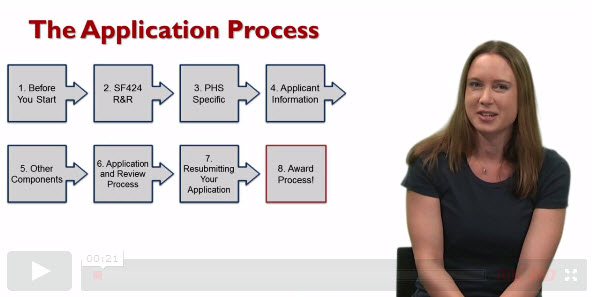
So You Want to Apply for an NRSA: Video resource
"The studio and Gary were the key resources," said Rettberg. "Without them I couldn't have created anything nearly as high-quality and professional."
The response to the videos online was immediate and positive, numbering among its early fans USC Graduate School Vice Provost Sally Pratt, PhD, and Executive Vice Provost Michael Quick, PhD. The Graduate School tweeted about the videos and posted links on the school's Facebook page.
"It's critical that applicants focus on the details as well as the whole picture, and Rettberg's presentation can save people enormous amounts of time and trouble," said Patino-Sutton. "Any student researcher interested in these sorts of grants should watch Rettberg's video series."
News of the series spread even to the NIH, where officials were similarly impressed – and welcoming. "This is the first tutorial focused on NRSAs by someone who has been through that process that I have ever seen, and it was excellent," said Dr. Molly Wagster, Rettberg's NIH program officer. "It is a wonderful resource for applicants."
SC CTSI is part of the 62-member Clinical and Translational Science Awards (CTSA) network funded through the National Center for Advancing Translational Sciences (NCATS) at the NIH (Grant Number UL1TR000130). Under the mandate of “Translating Science into Solutions for Better Health,” SC CTSI provides a wide range of resources, services, funding, and education for researchers and promotes online collaboration tools such as USC Profiles.
